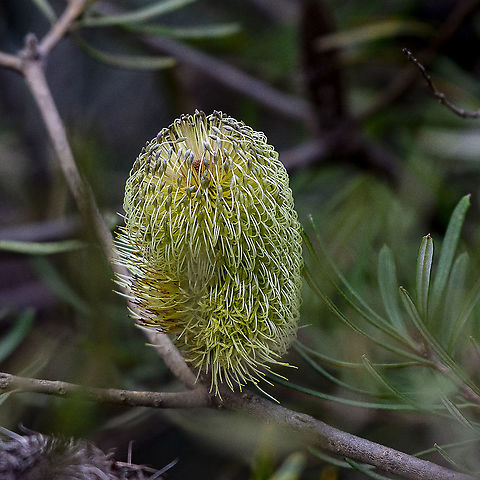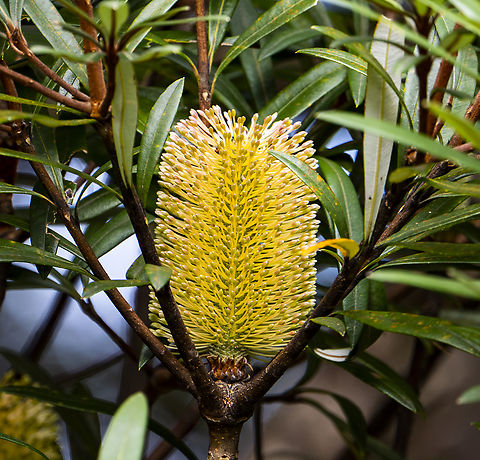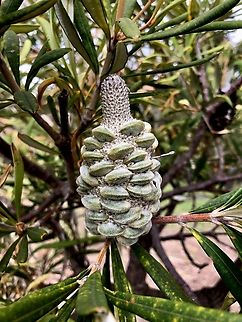
Appearance
"B. integrifolia" is a highly variable species. It is most often encountered as a tree up to 25 metres in height, but in sheltered locations it can reach 35 metres. In more exposed areas it may grow as a small, gnarled tree, reaching to no more than about 5 metres, and in highly exposed positions, such as on exposed coastal headlands, it may even be reduced to a small shrub.The tree usually has a single stout trunk, which is often twisted and gnarled, with the rough grey bark characteristic of "Banksia". The leaves are dark green with a white underside, and occur in whorls of three to five. Adult leaves have entire margins; George specifies their dimensions as 4–20 centimetres long and 6–35 millimetres wide, but "The Banksia Atlas" warns that "Atlas contributors found great variability in these measurements with specimens often falling outside the varietal limits specified by George or being intermediate between two varieties." Juvenile leaves have dentate margins with a few short teeth, and are generally larger than adult leaves.
Flowers occur in "Banksias characteristic "flower spike", an inflorescence made up of several hundred flowers densely packed in a spiral around a woody axis. This is roughly cylindrical, 10–12 centimetres high and 5 centimetres wide. Flowers are usually pale yellow to yellow, but may be greenish or pinkish in bud. Each individual flower consists of a tubular perianth made up of four united tepals, and one long wiry style. Characteristic of the taxonomic section in which it is placed, the styles are straight rather than hooked. The style ends are initially trapped inside the upper perianth parts, but break free at anthesis. This process starts with the flowers at the bottom of the inflorescence, sweeping up the spike at an unusually high rate of between 96 and 390 flowers per 24 hours.
The flower spikes are not as prominent as in some other "Banksia" species, as they arise from two- to three-year-old nodes nested within the foliage. After flowering, old flower parts wither and fall away over a period of several months, revealing the "cone", a woody axis embedded with many small follicles. The follicles are initially greenish and downy, but gradually fade to dark grey. Each follicle contains one or sometimes two seeds, separated by a thin wooden separator. The seed itself is black, 6–10 millimetres long with a feathery black 'wing' 10–20 millimetres long.

Naming
Now widely known as the coast banksia or coastal banksia, "B. integrifolia" was previously known by a range of common names. The "Checklist of Australian Trees" lists four other common names: honeysuckle, white banksia, white bottlebrush and white honeysuckle; and some older sources refer to it as honeysuckle oak.It was known to Indigenous Australians before its discovery and naming by Europeans; for example, the Gunai people of Gippsland called it. Because of its wide range it would have a name in a number of other indigenous languages, but these are now lost. In 2001, a search of historical archives for recorded indigenous names of Victorian flora and fauna failed to find a single name for the species.The names of three subspecies are accepted at the Australian Plant Census as at May 2020:
⤷ "B. integrifolia" subsp. "compar" K.R.Thiele;
⤷ "B. integrifolia" R.Br.subsp. "integrifolia";
⤷ "B. integrifolia" subsp. "monticola" K.R.Thiele.
Although some of the great variability of "B. integrifolia" can be attributed to environmental factors, much is genetic: George writes that it "gives the impression that it is actively speciating to fill the many ecological niches through its range". Genetic variation across its range has been mapped in some detail with microsatellite markers, facilitating further analysis of intraspecific relationships. Fractal analysis of the shape and spectrum of the leaves has been used to determine to which subspecies plants of unknown provenance belong.
;"Banksia integrifolia" subsp. "integrifolia"
⟶ The nominate subspecies occurs near the coast over most of the species' range except the far north. It varies little except in northern New South Wales and southern Queensland, where some populations appear to be intermediate with "B. integrifolia" subsp. "compar".
;"Banksia integrifolia" subsp. "compar"
⟶ This subspecies grows in coastal Queensland as far north as Proserpine. For most of its range it is the only subspecies, but near its southern limit it co-occurs with "B. integrifolia" subsp. "integrifolia". The two subspecies are distinguishable by their leaves, which are larger and glossy with wavy margins on "B. integrifolia" subsp. "compar".
;"Banksia integrifolia" subsp. "monticola"
⟶ Commonly known as white mountain banksia, it is the only subspecies with a montane distribution; it occurs in the Blue Mountains of northern New South Wales. It is similar in form to "B. integrifolia" subsp. "integrifolia", but differs in having longer, narrower leaves, and follicles that are more deeply embedded in the old flower spike.

Distribution
"B. integrifolia" is widely distributed, in both geographical and ecological terms. According to Alex George, "it spans a wider geographical and climatic range than any other species." Thiele and Ladiges make a similar claim: that its distribution "is a broader latitudinal, altitudinal and ecological amplitude than any other species, with the possible exception of "B. spinulosa"." No other species of tree occurs closer to the coast at Cape Byron, making "B. integrifolia" the most easterly tree on the Australian mainland.It occurs along almost the entire eastern coast of Australia, from Geelong, Victoria to Proserpine, Queensland. There was an isolated population on Long Island, Tasmania in 1999, and an 1876 record allegedly from King Island, although there has been speculation that that specimen was actually collected in the Furneaux Group. The species no longer occurs at any of these Tasmania locations, and has been declared extinct in Tasmania under that state's "Threatened Species Protection Act 1995". The range of latitude is thus about 20° to 38°S.
For most of its distribution, "B. integrifolia" occurs only within about 50 kilometres of the coast, where it typically occurs on poor quality sandy soils derived from sandstone. It grows near coastal cliffs and headlands, alongside river estuaries, and even on stabilised sand dunes. The temperature range for this area is around 0–30 °C, with almost no frosts. The species can occur in pure stands, but is usually associated with other species such as "Melaleuca quinquenervia", "Angophora costata", "Corymbia gummifera", "Eucalyptus botryoides", "Monotoca elliptica" and "Leptospermum laevigatum".
Between Sydney and Brisbane, "B. integrifolia" is found up to 200 kilometres inland, with "B. integrifolia" subsp. "monticola" occurring in the Blue Mountains at altitudes up to 1,500 metres. There it grows on better quality volcanic or rocky soils derived from granites and basalts, and would experience up to 100 frosts per year. In this montane habitat, it occurs in association with "Eucalyptus" species such as "E. viminalis" and "E. pauciflora", and also rainforest species such as "Nothofagus moorei" and "Orites excelsa".
References:
Some text fragments are auto parsed from Wikipedia.